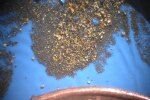I just bought the keene shaker table and can't figure this thing out for the life of me. Has anyone used this before. I'm getting most of my gold in port 1 but also alot of black sand. I try and re-run the black sand with the gold a second time with a little more slope and some of the gold goes into port 2 with the black sand and port 1 gets the same. I thought that port 1 was supposed to be all gold and no black sand. The instructions suck. Anything I have ever bought from Keene come with crappy instructions. Any help is appreciated.
Upvote
0








